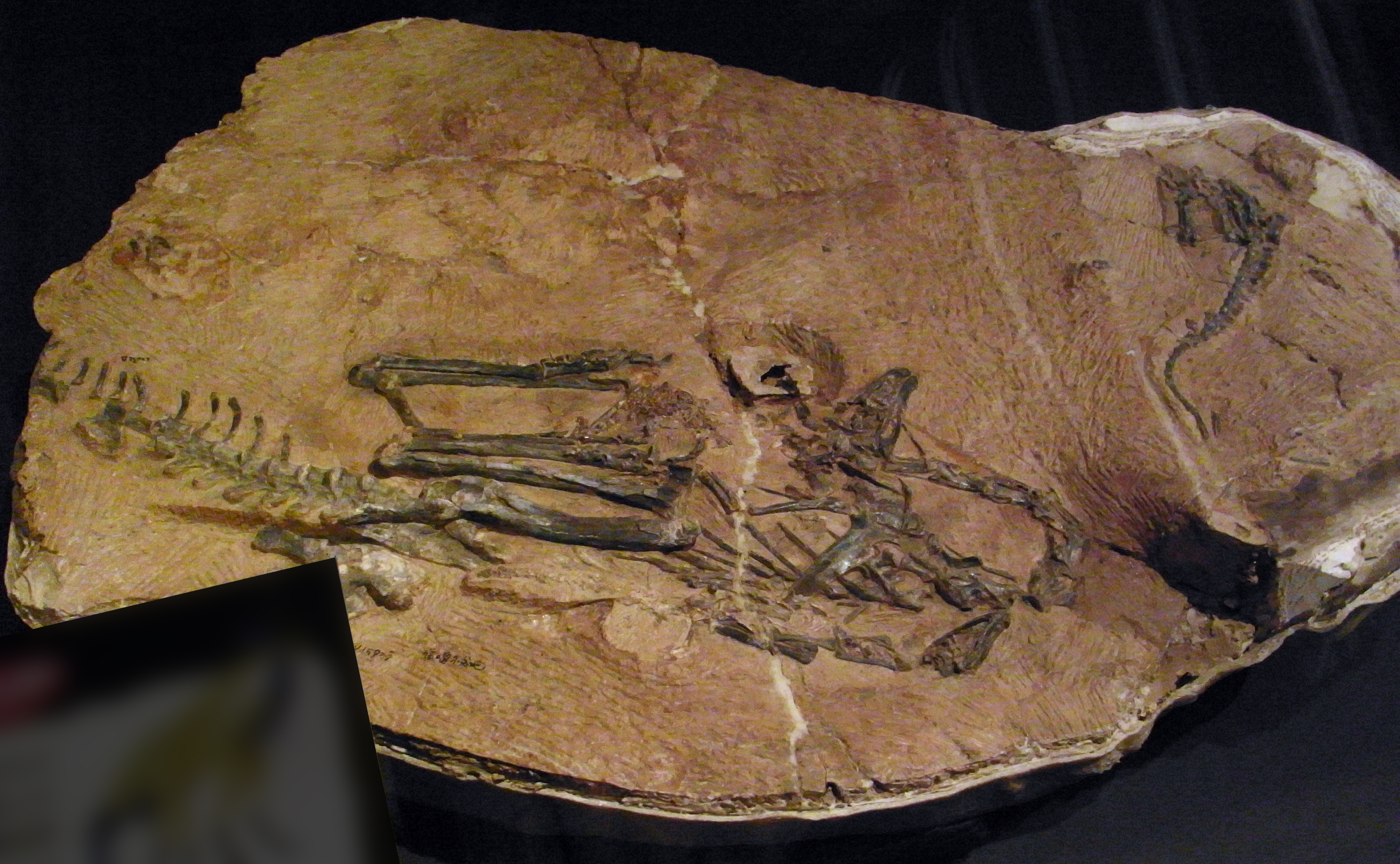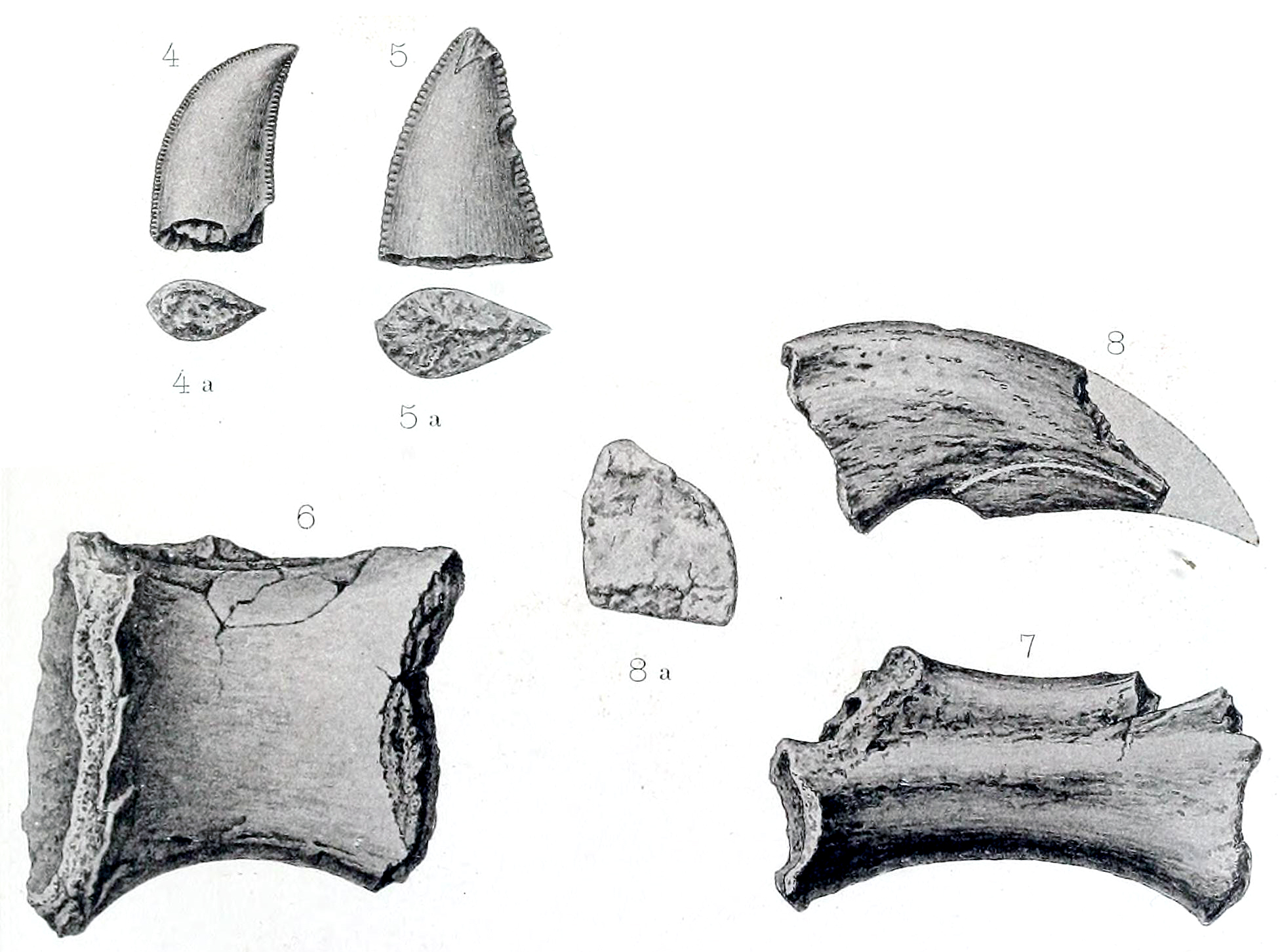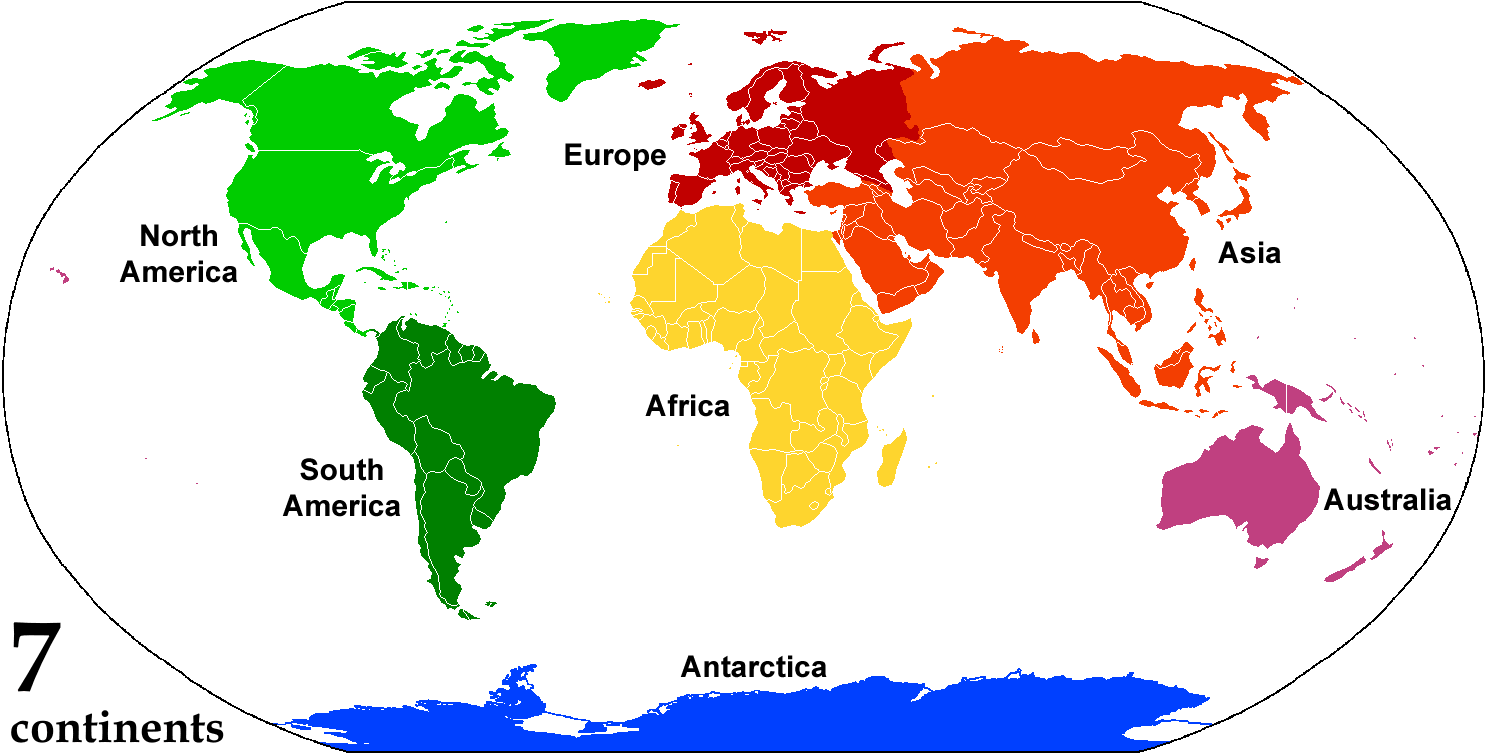|
Abelisaurids
Abelisauridae (meaning "Abel's lizards") is a family (biology), family (or clade) of ceratosaurian theropod dinosaurs. Abelisaurids thrived during the Cretaceous Period (geology), period, on the ancient southern supercontinent of Gondwana, and today their fossil remains are found on the modern continents of Africa and South America, as well as on the Indian subcontinent and the island of Madagascar. Isolated teeth were found in the Late Jurassic of Portugal, and the Late Cretaceous genera ''Tarascosaurus'', ''Arcovenator'' and ''Caletodraco'' have been described in France. Abelisaurids possibly first appeared during the Jurassic period based on fossil records, and some genera survived until the end of the Mesozoic era, around . Like most theropods, abelisaurids were carnivore, carnivorous bipeds. They were characterized by stocky hind limbs and extensive ornamentation of the skull bones, with grooves and pits. In many abelisaurids, such as ''Carnotaurus'', the forelimbs are vest ... [...More Info...] [...Related Items...] OR: [Wikipedia] [Google] [Baidu] |
Ceratosauria
Ceratosaurs are members of the clade Ceratosauria, a group of dinosaurs defined as all theropods sharing a more recent common ancestor with '' Ceratosaurus'' than with birds. The oldest known ceratosaur, '' Saltriovenator'', dates to the earliest part of the Jurassic, around 199 million years ago. Ceratosauria includes three major clades: Ceratosauridae, Noasauridae, and Abelisauridae, found primarily (though not exclusively) in the Southern Hemisphere. Originally, Ceratosauria included the above dinosaurs plus the Late Triassic to Early Jurassic Coelophysoidea and Dilophosauridae, implying a much earlier divergence of ceratosaurs from other theropods. However, most recent studies have shown that coelophysoids and dilophosaurids do not form a natural group with other ceratosaurs, and are excluded from this group. Ceratosauria derives its names from the type species, '' Ceratosaurus nasicornis'', described by O.C. Marsh in 1884. A moderately large predator from the Late Jura ... [...More Info...] [...Related Items...] OR: [Wikipedia] [Google] [Baidu] |
Majungasaurus Crenatissimus
''Majungasaurus'' (; ) is a genus of abelisaurid theropod dinosaur that lived in Madagascar from 70 to 66 million years ago, at the end of the Cretaceous Period (geology), Period, making it one of the last-known non-avian dinosaurs that went extinct during the Cretaceous–Paleogene extinction event. The genus contains a single species, ''Majungasaurus crenatissimus''. This dinosaur is also called ''Majungatholus'', a name which is considered a junior synonym of ''Majungasaurus''. Like other abelisaurids, ''Majungasaurus'' was a bipedal predator with a short snout. Although the forelimbs are not completely known, they were very short, while the hind limbs were longer and very stocky. Measuring around long and weighing more than , it can be distinguished from other abelisaurids by its wider skull, the very rough texture and thickened bone on the top of its snout, and the single rounded horn on the roof of its skull, which was originally mistaken for the dome of a pachycephalosa ... [...More Info...] [...Related Items...] OR: [Wikipedia] [Google] [Baidu] |
Kryptops
''Kryptops'' (meaning "covered face") is an extinct genus of abelisaurid theropod dinosaurs from the Early Cretaceous of Niger. It is known from a partial maxilla (upper jaw bone) found at the Gadoufaoua locality in the western Ténéré Desert, in rocks of the Aptian–Albian-age Elrhaz Formation. The fossils were collected in 2000 by a University of Chicago expedition to Niger led by American paleontologist Paul Sereno. They were then described in 2008 by Sereno and Stephen L. Brusatte, Steve Brusatte. The genus contains a monotypic taxon, single species, ''Kryptops palaios''. Sereno and Brusatte referred several Postcranium, postcranial remains to ''Kryptops'', but later studies have shown that these elements belong to an allosauroid theropod, leaving ''Kryptops'' to be only known from the incomplete maxilla. ''Kryptops'' is one of the oldest known members of the Abelisauridae, making it vital to understanding this family's evolution. Its length is estimated to be around , mak ... [...More Info...] [...Related Items...] OR: [Wikipedia] [Google] [Baidu] |
Jurassic
The Jurassic ( ) is a Geological period, geologic period and System (stratigraphy), stratigraphic system that spanned from the end of the Triassic Period million years ago (Mya) to the beginning of the Cretaceous Period, approximately 143.1 Mya. The Jurassic constitutes the second and middle period of the Mesozoic, Mesozoic Era as well as the eighth period of the Phanerozoic, Phanerozoic Eon and is named after the Jura Mountains, where limestone strata from the period were first identified. The start of the Jurassic was marked by the major Triassic–Jurassic extinction event, associated with the eruption of the Central Atlantic magmatic province, Central Atlantic Magmatic Province (CAMP). The beginning of the Toarcian Age started around 183 million years ago and is marked by the Toarcian Oceanic Anoxic Event, a global episode of Anoxic event, oceanic anoxia, ocean acidification, and elevated global temperatures associated with extinctions, likely caused by the eruption of the Kar ... [...More Info...] [...Related Items...] OR: [Wikipedia] [Google] [Baidu] |
Brachyrostra
Brachyrostra (meaning "short snouts") is a clade within the theropod dinosaur family Abelisauridae. It includes the famous genera ''Carnotaurus'', ''Aucasaurus'', potentially ''Abelisaurus'' as well as their close relatives from the Cretaceous Period of Argentina and Brazil plus ''Caletodraco'' from France. The group was first proposed in an analysis conducted by Juan Canale and colleagues in 2008. They found that all South American abelisaurids described up to that point grouped together as a sub-clade of Abelisauridae, which they named based on the relatively unusual shape of their skulls (in comparison with other theropods). They defined the clade Brachyrostra as "all the abelisaurids more closely related to ''Carnotaurus sastrei'' than to ''Majungasaurus crenatissimus''." Paleobiology Anatomy Brachyrostrans were relatively lightly built compared to other large theropods, ranging in size from 6.1–7.8 m (20–26 ft) and 1400–2000 kg (1.6–2.3 short tons) in weig ... [...More Info...] [...Related Items...] OR: [Wikipedia] [Google] [Baidu] |
Continent
A continent is any of several large geographical regions. Continents are generally identified by convention (norm), convention rather than any strict criteria. A continent could be a single large landmass, a part of a very large landmass, as in the case of Asia or Europe within Eurasia, or a landmass and nearby islands within its continental shelf. Due to these varying definitions, the number of continents varies; up to seven or as few as four geographical regions are commonly regarded as continents. Most English-speaking world, English-speaking countries recognize seven regions as continents. In order from largest to smallest in area, these seven regions are Asia, Africa, North America, South America, Antarctica, Europe, and Australia (continent), Australia (sometimes called Oceania or Australasia). Different variations with fewer continents merge some of these regions; examples of this are merging Asia and Europe into Eurasia, "Most people recognize seven continents—Asia, ... [...More Info...] [...Related Items...] OR: [Wikipedia] [Google] [Baidu] |
Fossil
A fossil (from Classical Latin , ) is any preserved remains, impression, or trace of any once-living thing from a past geological age. Examples include bones, shells, exoskeletons, stone imprints of animals or microbes, objects preserved in amber, hair, petrified wood and DNA remnants. The totality of fossils is known as the ''fossil record''. Though the fossil record is incomplete, numerous studies have demonstrated that there is enough information available to give a good understanding of the pattern of diversification of life on Earth. In addition, the record can predict and fill gaps such as the discovery of '' Tiktaalik'' in the arctic of Canada. Paleontology includes the study of fossils: their age, method of formation, and evolutionary significance. Specimens are sometimes considered to be fossils if they are over 10,000 years old. The oldest fossils are around 3.48 billion years to 4.1 billion years old. Early edition, published online before prin ... [...More Info...] [...Related Items...] OR: [Wikipedia] [Google] [Baidu] |
Gondwana
Gondwana ( ; ) was a large landmass, sometimes referred to as a supercontinent. The remnants of Gondwana make up around two-thirds of today's continental area, including South America, Africa, Antarctica, Australia (continent), Australia, Zealandia, Arabian Peninsula, Arabia, and the Indian subcontinent. Gondwana was formed by the Accretion (geology), accretion of several cratons (large stable blocks of the Earth's crust), beginning with the East African Orogeny, the collision of India and Geography of Madagascar, Madagascar with East Africa, and culminating in with the overlapping Brasiliano orogeny, Brasiliano and Kuunga orogeny, Kuunga orogenies, the collision of South America with Africa, and the addition of Australia and Antarctica, respectively. Eventually, Gondwana became the largest piece of continental crust of the Paleozoic Era, covering an area of some , about one-fifth of the Earth's surface. It fused with Laurasia during the Carboniferous to form Pan ... [...More Info...] [...Related Items...] OR: [Wikipedia] [Google] [Baidu] |
Supercontinent
In geology, a supercontinent is the assembly of most or all of Earth's continent, continental blocks or cratons to form a single large landmass. However, some geologists use a different definition, "a grouping of formerly dispersed continents", which leaves room for interpretation and is easier to apply to Precambrian times. To separate supercontinents from other groupings, a limit has been proposed in which a continent must include at least about 75% of the continental crust then in existence in order to qualify as a supercontinent. Moving under the forces of plate tectonics, supercontinents have assembled and dispersed multiple times in the geologic past. According to modern definitions, a supercontinent does not exist today; the closest is the current Afro-Eurasian landmass, which covers approximately 57% of Earth's total land area. The last period in which the continental landmasses were near to one another was 336 to 175 million years ago, forming the supercontinent Pangaea ... [...More Info...] [...Related Items...] OR: [Wikipedia] [Google] [Baidu] |
Period (geology)
The geologic time scale or geological time scale (GTS) is a representation of time based on the rock record of Earth. It is a system of chronological dating that uses chronostratigraphy (the process of relating strata to time) and geochronology (a scientific branch of geology that aims to determine the age of rocks). It is used primarily by Earth scientists (including geologists, paleontologists, geophysicists, geochemists, and paleoclimatologists) to describe the timing and relationships of events in geologic history. The time scale has been developed through the study of rock layers and the observation of their relationships and identifying features such as lithologies, paleomagnetic properties, and fossils. The definition of standardised international units of geological time is the responsibility of the International Commission on Stratigraphy (ICS), a constituent body of the International Union of Geological Sciences (IUGS), whose primary objective is to precisely ... [...More Info...] [...Related Items...] OR: [Wikipedia] [Google] [Baidu] |
Cretaceous
The Cretaceous ( ) is a geological period that lasted from about 143.1 to 66 mya (unit), million years ago (Mya). It is the third and final period of the Mesozoic Era (geology), Era, as well as the longest. At around 77.1 million years, it is the ninth and longest geological period of the entire Phanerozoic. The name is derived from the Latin , 'chalk', which is abundant in the latter half of the period. It is usually abbreviated K, for its German translation . The Cretaceous was a period with a relatively warm climate, resulting in high Sea level#Local and eustatic, eustatic sea levels that created numerous shallow Inland sea (geology), inland seas. These oceans and seas were populated with now-extinct marine reptiles, ammonites, and rudists, while dinosaurs continued to dominate on land. The world was largely ice-free, although there is some evidence of brief periods of glaciation during the cooler first half, and forests extended to the poles. Many of the dominant taxonomic gr ... [...More Info...] [...Related Items...] OR: [Wikipedia] [Google] [Baidu] |
Dinosaur
Dinosaurs are a diverse group of reptiles of the clade Dinosauria. They first appeared during the Triassic Geological period, period, between 243 and 233.23 million years ago (mya), although the exact origin and timing of the #Evolutionary history, evolution of dinosaurs is a subject of active research. They became the dominant terrestrial vertebrates after the Triassic–Jurassic extinction event 201.3 mya and their dominance continued throughout the Jurassic and Cretaceous periods. The fossil record shows that birds are feathered dinosaurs, Evolution of birds, having evolved from earlier Theropoda, theropods during the Late Jurassic epoch, and are the only dinosaur lineage known to have survived the Cretaceous–Paleogene extinction event approximately 66 mya. Dinosaurs can therefore be divided into avian dinosaurs—birds—and the extinct non-avian dinosaurs, which are all dinosaurs other than birds. Dinosaurs are varied from taxonomy (biology), taxonomic, ... [...More Info...] [...Related Items...] OR: [Wikipedia] [Google] [Baidu] |











